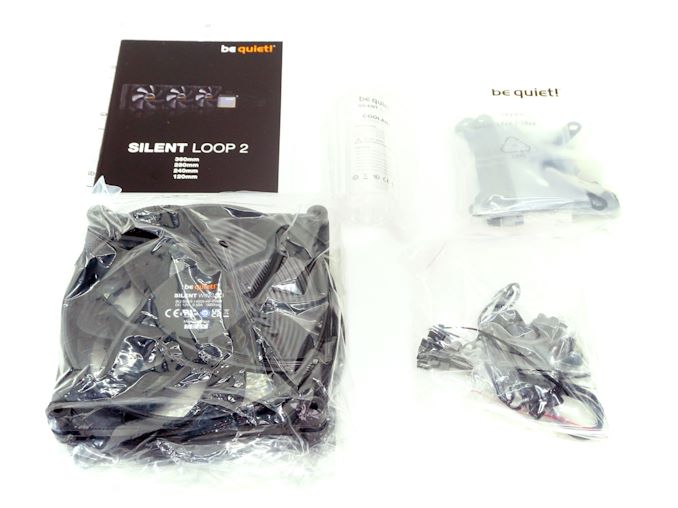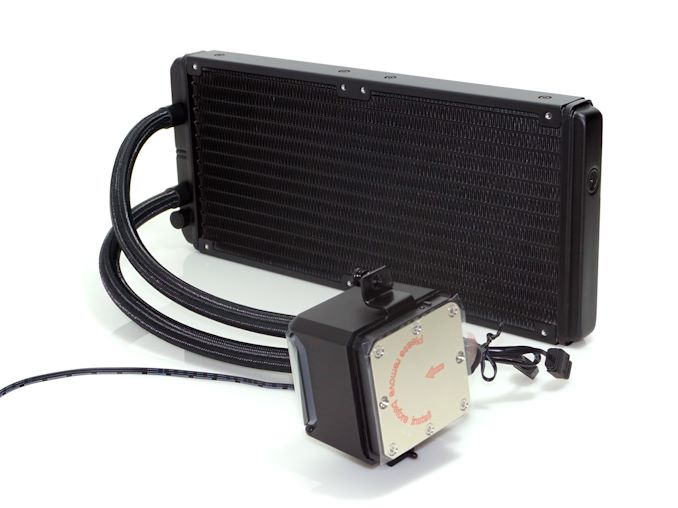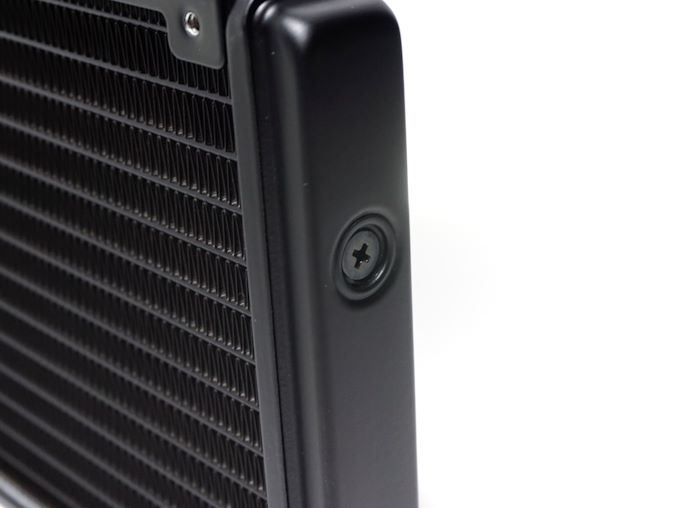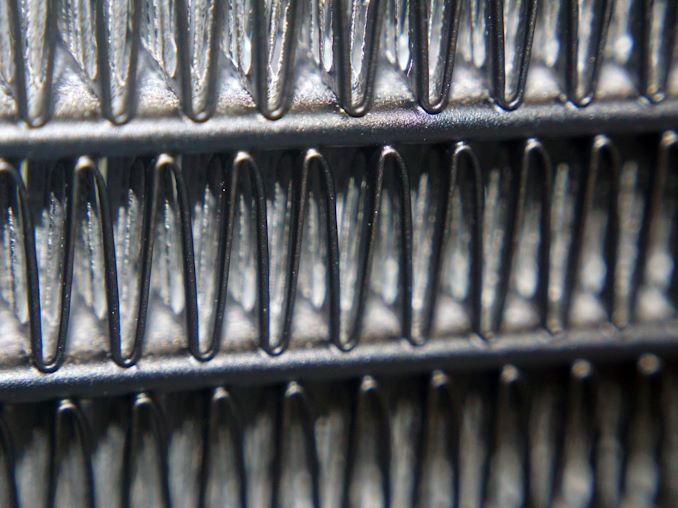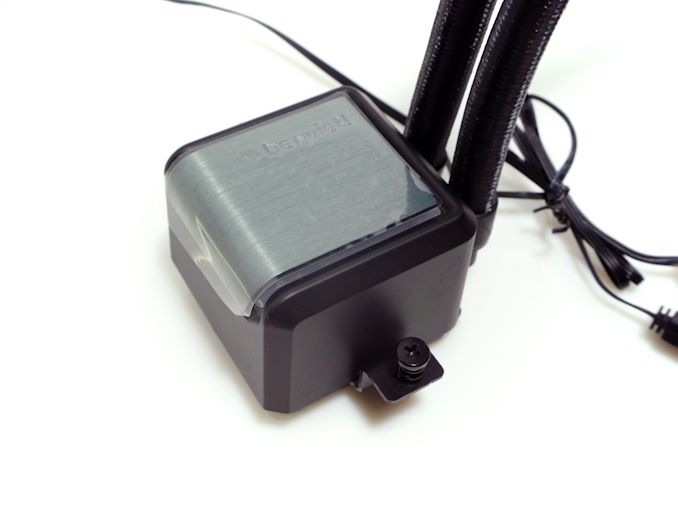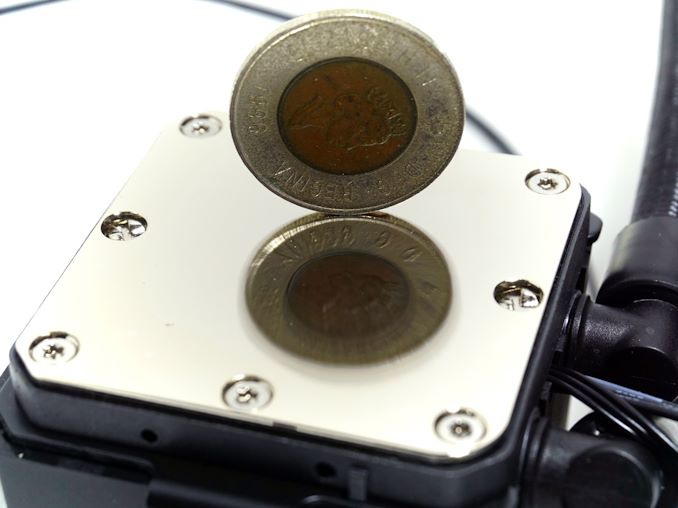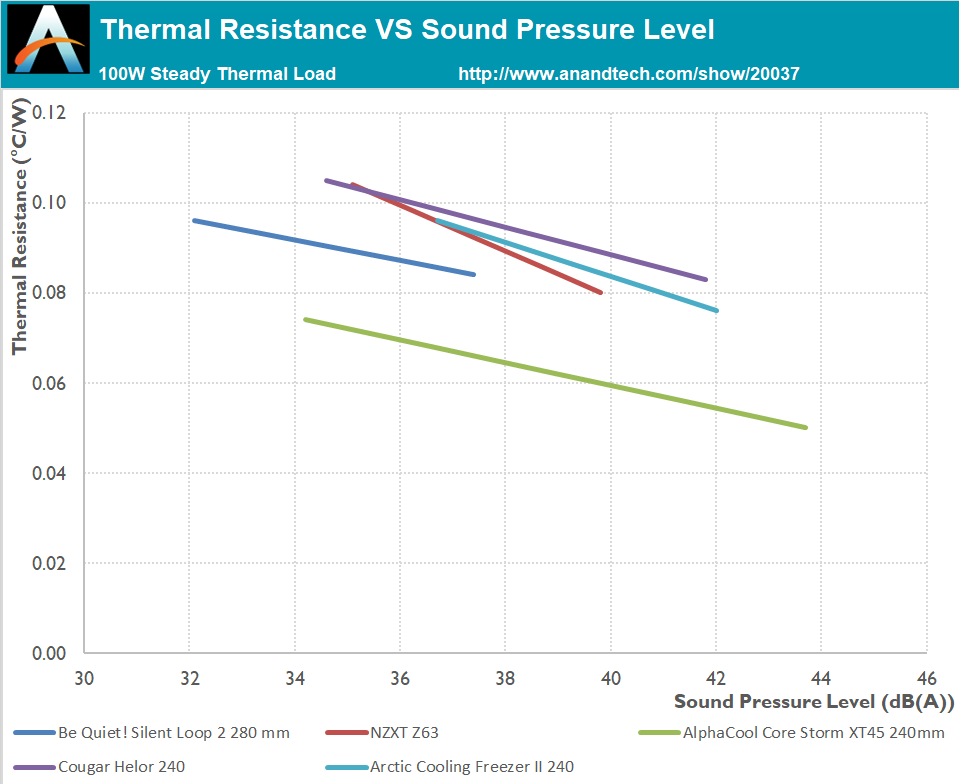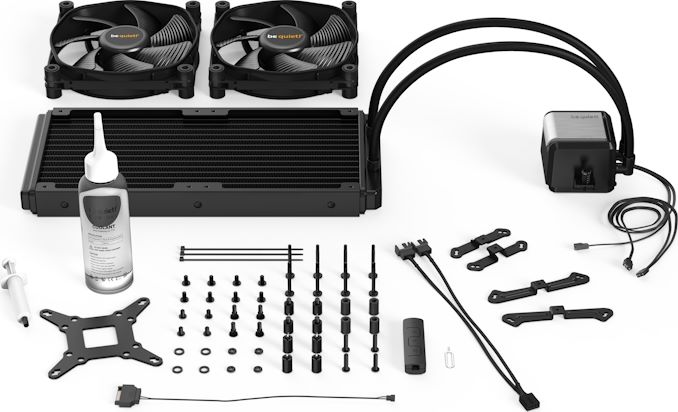
Original Link: https://www.anandtech.com/show/20037/the-be-quiet-silent-loop-2-aio-cooler-review
The Be Quiet! Silent Loop 2 AIO Cooler Review: Quiet and Unassuming
by E. Fylladitakis on September 7, 2023 9:30 AM EST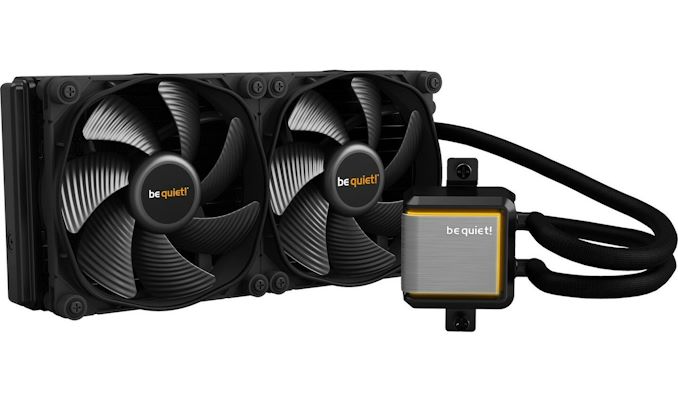
A familiar presence here at AnandTech, Be Quiet! has settled in to distinct niche for itself in the PC peripherals market over the years by simply living up to the company's name. Tuning their device designs for minimal acoustics, the company successfully expanded into all-in-one (AIO) liquid coolers back in 2016. It's a product segment where, even though the design of closed-loop systems is quite restrictive, the company’s engineers have always been trying to innovate and differ from the competition. A prime example of this approach could be the Pure Loop series that hit the market back in 2020, which had a decoupled liquid pump.
Jumping forward to the present, today we are taking a look at the latest AIO cooler series from Be Quiet!, the Silent Loop 2. This is an advanced cooler series that is designed to fully maximize the performance-to-noise ratio for demanding users. The Silent Loop 2 series consists of four coolers that are, as is usually the case, practically identical with the exception of the radiator size, which ranges from 120 mm to 360 mm.
For our review we received the most popular version of the series, the 280 mm Silent Loop 2 cooler.
| Be Quiet! Silent Loop 2 AIO CPU Cooler Specifications | |||
| Type | All-in-One Liquid Cooler | ||
| Dimensions | 314 x 140 x 52 (radiator with fan) 94.5 x 80 x 54 (cooling block) |
||
| Fans | 2 x 140 mm "Silent Wings 3" Fan 1600 RPM (max) |
||
| RGB | Yes (ARGB) | ||
| Supported Sockets | Intel: LGA1700 / LGA1200 / LGA115x / LGA2066/ LGA2011(-3) Square ILM AMD: AM5 / AM4 / sTRX4 / TR4(optional, mounting-kit BZ008) |
||
| Warranty | 3 Years | ||
| Price | $207 / €139 | ||
Packaging & Bundle
Be Quiet! supplies the Silent Loop 2 cooler in an aesthetically simple but very sturdy cardboard box. Inside the box, we find the cooler and its accessories well protected by a custom internal paper insert. A wealth of information regarding the cooler can be found on the sides and rear of the box.
Inside the box, we found a small but well-written manual, the necessary socket mounting hardware, a small syringe with a little thermal grease, and adapters for powering the fans. Be Quiet! also supplies a bottle of coolant that can be used to replenish the cooler’s liquid if deemed necessary.
The fans provided alongside the Silent Loop 2 cooler are Be Quiet!’s own Silent Wings 3 premium fans. Naturally, two 140 mm fans are supplied with the 280 mm version that we are reviewing today. These fans have fluid-dynamic bearings and six-pole engines to minimize their noise output. Their maximum speed is 1600 RPM, a reasonable figure for use on a performance AIO cooler.
The Be Quiet! Silent Loop 2 280mm AIO Cooler
In terms of basic design, the Silent Loop 2 280 mm AIO cooler is a typical AIO cooler, with a single cooling block/pump assembly and two hoses leading to the radiator. Although the company claims that the Silent Loop 2 cooler incorporates a “powerful pump”, the size of the main block is smaller than most.
The radiator is a typical dual pass cross-flow design, with tiny fins soldered on thin oblong tubes and space for two 140 mm fans. From a baseline point of view, it is the same typical design that every AIO cooler is using nowadays, as no other heat exchanger design manages to outperform it in PC cooling applications. The only atypical feature is the filling port plug that can be used to replenish the system’s coolant. Archetypally, such systems are considered sealed and evaporation of the coolant to a point that would affect its performance should take several years to occur, but it is not an impossible thing to happen. Be Quiet!’s filling port provides peace of mind to users that hold on to their purchased equipment for more than a couple of years.
A close look at the radiator’s fins reveals that they are not solid, but rather they're notched. We have seen other manufacturers experimenting with the formation of the radiator’s fins before in an effort to improve the overall performance of their products, so that did not surprise us. Be Quiet’s approach reduces the surface area of the fins in exchange for better airflow and lower noise.
The cubic pump block is of simple design, not too small but not large either. Most of the block’s body is made out of plastic, with steel mounting brackets and a solid copper contact plate. A thin cover that appears like brushed aluminum decorates the top side of the block. Both connectors are L-shaped and offer a good range of adjustments.
The contact plate is machined down to an immaculate mirror finish. It is square, with a surface area that can easily cover every CPU shim plate this cooler supports right out of the box. The company does offer an optional TR4/sTRX4 mounting kit.
Be Quiet! implemented subtle ARGB lighting on the pump block of the Silent Loop 2 in the form of a lighting frame surrounding the brushed metal cover. For users whose motherboard does not support ARGB control, Be Quiet includes a stand-alone controller that can be used to perform basic visual effects. For such a small, subtle implementation, the quality of the lighting is extraordinary, with no intensity fluctuations or inconsistent spots across the frame. There is no ARGB lighting on the fans or radiator, which can be a good or bad thing, depending on how extravagant one likes their system to look.
Testing Methodology
Although the testing of a cooler appears to be a simple task, that could not be much further from the truth. Proper thermal testing cannot be performed with a cooler mounted on a single chip, for multiple reasons. Some of these reasons include the instability of the thermal load and the inability to fully control and or monitor it, as well as the inaccuracy of the chip-integrated sensors. It is also impossible to compare results taken on different chips, let alone entirely different systems, which is a great problem when testing computer coolers, as the hardware changes every several months. Finally, testing a cooler on a typical system prevents the tester from assessing the most vital characteristic of a cooler, its absolute thermal resistance.
The absolute thermal resistance defines the absolute performance of a heatsink by indicating the temperature rise per unit of power, in our case in degrees Celsius per Watt (°C/W). In layman's terms, if the thermal resistance of a heatsink is known, the user can assess the highest possible temperature rise of a chip over ambient by simply multiplying the maximum thermal design power (TDP) rating of the chip with it. Extracting the absolute thermal resistance of a cooler however is no simple task, as the load has to be perfectly even, steady and variable, as the thermal resistance also varies depending on the magnitude of the thermal load. Therefore, even if it would be possible to assess the thermal resistance of a cooler while it is mounted on a working chip, it would not suffice, as a large change of the thermal load can yield much different results.
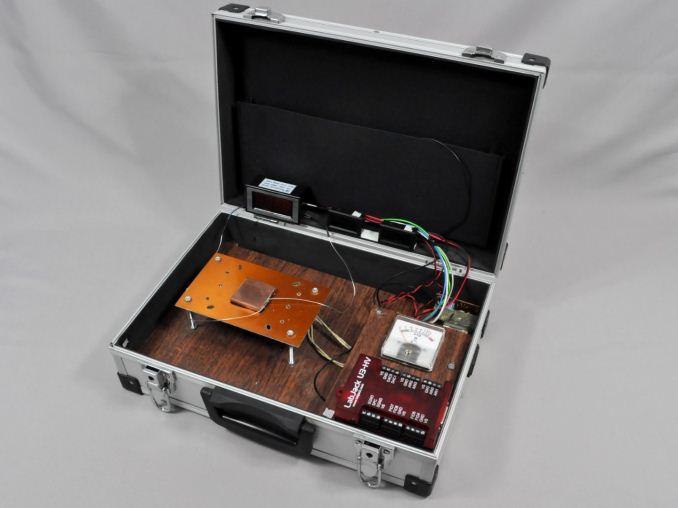
Appropriate thermal testing requires the creation of a proper testing station and the use of laboratory-grade equipment. Therefore, we created a thermal testing platform with a fully controllable thermal energy source that may be used to test any kind of cooler, regardless of its design and or compatibility. The thermal cartridge inside the core of our testing station can have its power adjusted between 60 W and 340 W, in 2 W increments (and it never throttles). Furthermore, monitoring and logging of the testing process via software minimizes the possibility of human errors during testing. A multifunction data acquisition module (DAQ) is responsible for the automatic or the manual control of the testing equipment, the acquisition of the ambient and the in-core temperatures via PT100 sensors, the logging of the test results and the mathematical extraction of performance figures.
Finally, as noise measurements are a bit tricky, their measurement is being performed manually. Fans can have significant variations in speed from their rated values, thus their actual speed during the thermal testing is being recorded via a laser tachometer. The fans (and pumps, when applicable) are being powered via an adjustable, fanless desktop DC power supply and noise measurements are being taken 1 meter away from the cooler, in a straight line ahead from its fan engine. At this point we should also note that the Decibel scale is logarithmic, which means that roughly every 3 dB(A) the sound pressure doubles. Therefore, the difference of sound pressure between 30 dB(A) and 60 dB(A) is not "twice as much" but nearly a thousand times greater. The table below should help you cross-reference our test results with real-life situations.
The noise floor of our recording equipment is 30.2-30.4 dB(A), which represents a medium-sized room without any active noise sources. All of our acoustic testing takes place during night hours, minimizing the possibility of external disruptions.
| <35dB(A) | Virtually inaudible |
| 35-38dB(A) | Very quiet (whisper-slight humming) |
| 38-40dB(A) | Quiet (relatively comfortable - humming) |
| 40-44dB(A) | Normal (humming noise, above comfortable for a large % of users) |
| 44-47dB(A)* | Loud* (strong aerodynamic noise) |
| 47-50dB(A) | Very loud (strong whining noise) |
| 50-54dB(A) | Extremely loud (painfully distracting for the vast majority of users) |
| >54dB(A) | Intolerable for home/office use, special applications only. |
*noise levels above this are not suggested for daily use
Testing Results, Maximum Fan Speed
Our maximum speed testing is performed with both the fans and the pump of the kit powered via a 12V DC source. This input voltage should have the pump and fans matching the speed ratings of the manufacturer. The Silent Wings 3 fans rotate at just a little below their rated speed, with our tachometer reading 1590 RPM. We got the exact same speed readings from both fans, a hint of good manufacturing consistency.

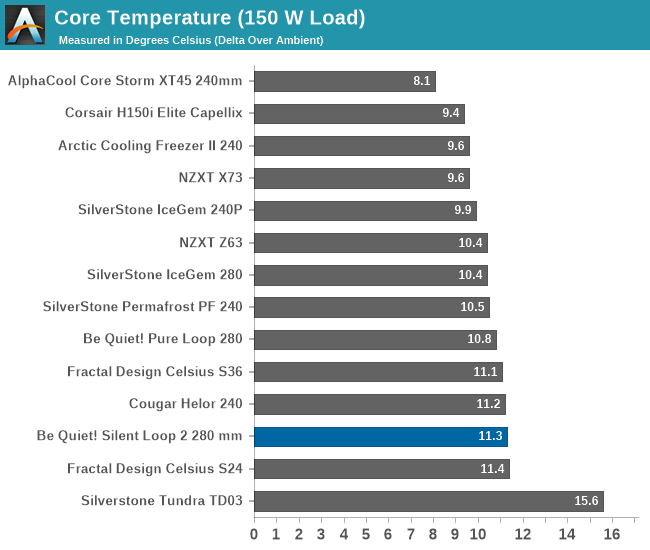
| Core Temperature, Constant Thermal Load (Max Fan Speed) |
The thermal performance of the Silent Loop 2 280 mm cooler initially appears unimpressive in comparison to other AIO coolers of similar size. The average thermal resistance of 0.081 °C/W may be adequate for a modern CPU, but is a figure that many other similarly sized – and even smaller – products can achieve. That includes Be Quiet!’s older Pure Loop range of AIO coolers.
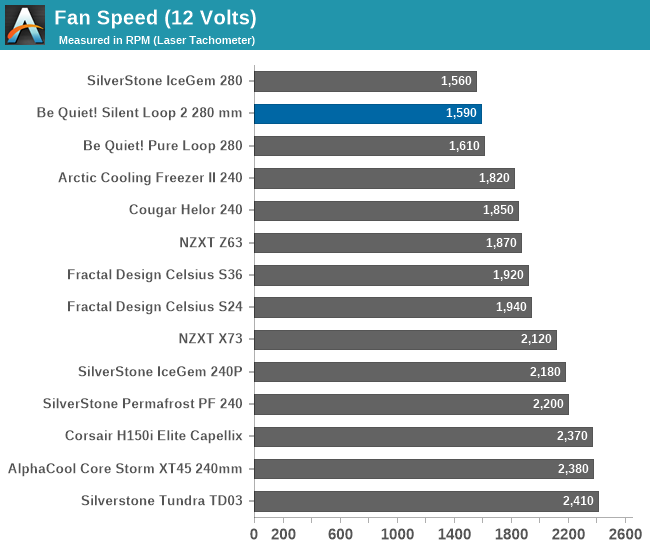
In complete contradiction to the thermal performance results, the acoustics performance of the Silent Loop 2 is exceptional. With both of its fans at maximum speed, our meter took a reading of just 37.4 dB(A). It is an audible figure but one that would be comfortable for typical daytime use. We could not discern any noise coming from the liquid pump at all.
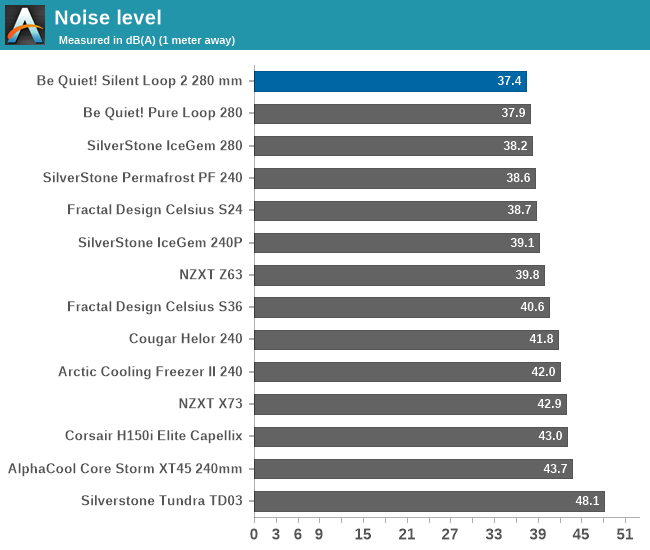
Testing Results, Low Fan Speed
Using a PWM voltage regulator, we reduced the speed of the fans manually down to half their rated speed, which is 800 RPM for the Silent Wings 3 140 mm fans. The pump was also connected to the same power source, functioning properly at this low speed setting.


| Core Temperature, Constant Thermal Load (Low Fan Speed) |
Thermally, the results indicate that the Silent Loop 2 performs similarly to other comparable AIO cooler designs, yet is a step behind most. The average thermal permittance of 0.1026 °C/W is a good figure but hardly impressive for a 280 mm liquid cooler. At first sight, one can discern that even some designs with 240 mm radiators perform better – however, a closer look reveals that the fans of the Silent Loop 2 rotate at a very low speed during this test.
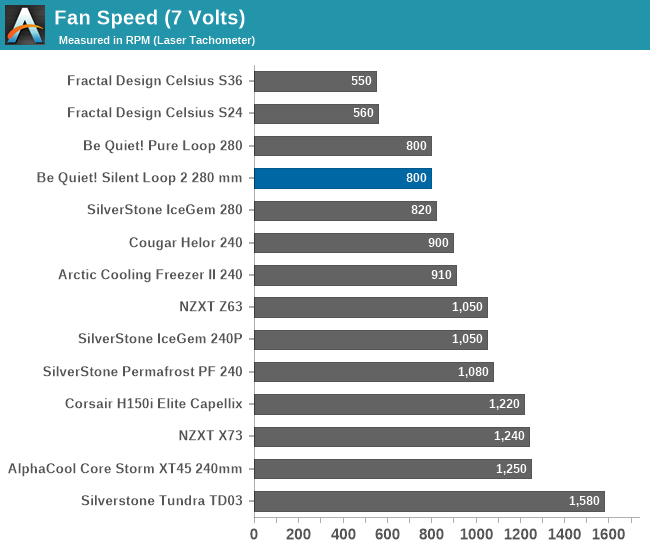
Much like our previous tests, the noise output of the Be Quiet! Silent Loop 2 under these operating conditions is extremely low, at just 32.1 dB(A). To regular human ears, this is entirely inaudible from a distance of one meter. There also is no noise coming from the main block assembly at all, with the pump managing to operate without even the slightest hydrodynamic noise coming from it. Although the Be Quiet! Silent Loop 2 does not sit all by itself at the top of the chart, 32.1 dB(A) is the lowest sound pressure level figure we have recorded from AIO coolers to this date.
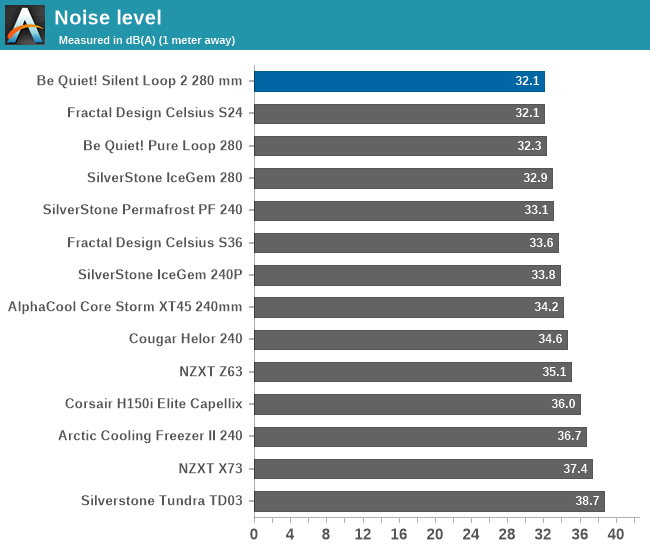
Thermal Resistance VS Sound Pressure Level
During our thermal resistance vs. sound pressure level test, we maintain a steady 100W thermal load and assess the overall performance of the coolers by taking multiple temperatures and sound pressure level readings within the operating range of the stock cooling fans. The result is a graph that depicts the absolute thermal resistance of the cooler in comparison to the noise generated. For both the sound pressure level and absolute thermal resistance readings, lower figures are better.
This graph reveals the true strength of the Silent Loop 2 AIO cooler, which is no other than silent operation. The thermal resistance range of the cooler is small, suggesting that only a significant change in the speed of its fans would make a tangible performance difference. Regardless, the Silent Loop 2 achieves these thermal resistance figures at significantly lower dB(A) than other similarly sized AIO coolers. Only custom liquid cooling kits that are significantly more powerful (and expensive) have a notable performance edge over the Silent Loop 2.
Conclusion
Wrapping things up, the Be Quiet! Silent Loop 2 280 mm AIO cooler presents a mix of commendable attributes and certain shortcomings, making it a noteworthy contender in the realm of liquid cooling solutions. While its thermal performance falls within the realm of mediocrity, its undeniable standout feature is its exceptionally low noise output. This is a crucial consideration for enthusiasts and professionals seeking a serene computing environment without significantly sacrificing effective heat dissipation, and it's where the Silent Loop 2 makes sure to live up to its name.
The simplicity of design and high manufacturing quality is a hallmark of Be Quiet!’s products. The radiator is based on a common but proven design, ensuring that it efficiently dissipates heat while offering the convenience of a filling port, instilling confidence in users who prioritize the longevity of their hardware investments. The main block assembly of the cooler showcases a blend of practicality and aesthetics. The tasteful incorporation of RGBW lighting communicates a touch of elegance without veering into flashiness, catering to those who prefer subtle visual enhancements.
However, the Be Quiet! Silent Loop 2 AIO cooler is not without its trade-offs. The cooler can be hard to find in the US, and as a result its current retail price runs rather high, at around $207. Understandably, this might deter some potential buyers, particularly when considering the cooler's middling thermal performance. On the other hand, over in the European market the cooler can be found for around €139 (~$149), presenting a far more reasonable proposition.
Overall, the Be Quiet! Silent Loop 2 AIO cooler offers a harmonious fusion of simplicity, quality, and subdued elegance. While its thermal performance might not be at the forefront of its features, its exceptionally quiet operation is a standout trait that should please its intended demographic. With a straightforward design and tasteful aesthetics, it caters to users who prioritize a refined appearance and low noise levels. Given this, the higher cost in the US market and limited availability make it a tough sell, but the more reasonable European pricing makes it an appealing choice for those across the Atlantic. As the landscape of cooling solutions evolves, the Be Quiet! Silent Loop 2 AIO cooler maintains its relevance by appealing to users who seek an unobtrusive, well-crafted, and serene computing experience.


